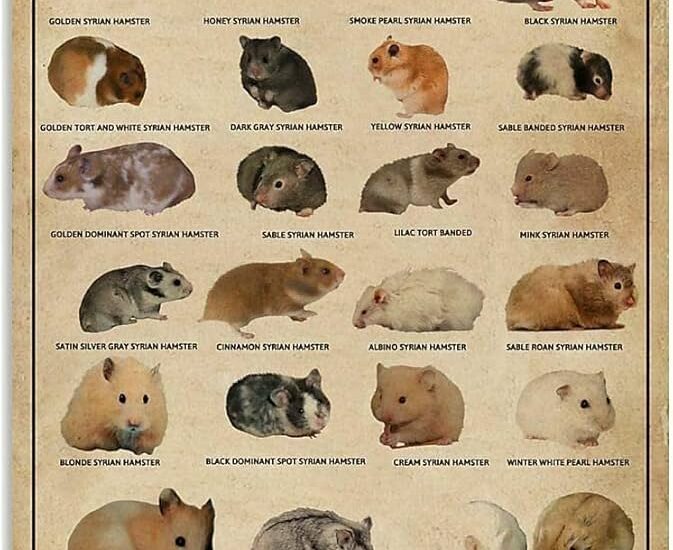Popular Hamster Breeds for Family Homes
Hamsters are among the most beloved pets in family homes. Their adorable appearance, playful demeanor, and relatively low maintenance needs make them ideal companions for both children and adults. The joy of watching a hamster run on its wheel or explore its environment can provide countless hours of entertainment. However, with numerous breeds available, selecting the right one for your family can be a challenge. This article will explore the most popular hamster breeds, detailing their unique characteristics, care requirements, and what makes each breed special.
The Appeal of Hamsters as Pets
Hamsters offer various advantages that make them suitable for families. Firstly, they are small in size, meaning they don’t require a large living space. Secondly, hamsters are relatively easy to care for; they do not need to be taken for walks like dogs, nor do they require the extensive grooming that some other pets do. Additionally, hamsters have engaging personalities which can be enjoyable for families, especially for children who are learning responsibility in caring for a living creature.
Understanding Hamster Breeds
Not all hamsters are the same. Each breed has its own temperamental traits and care needs. Understanding these nuances can assist you in choosing the best pet for your family. Here, we will outline some of the most popular hamster breeds, helping you make an informed decision.
1. Syrian Hamster
One of the most popular breeds, the Syrian hamster, also known as the golden hamster, is typically larger than other varieties. These hamsters are known for their friendly and docile nature, making them ideal for families. They come in various colors and fur types, including short-haired and long-haired varieties.
Key Characteristics:
- Size: 6-7 inches long
- Lifespan: 2-3 years
- Temperament: Friendly and easy to handle
- Socialization: Prefer solitary living, so should be kept alone

Care Tips:
Provide a spacious cage, chew toys, and a balanced diet. Regular interaction will help them remain friendly and sociable.
2. Dwarf Campbell Russian Hamster
This breed is slightly smaller than the Syrian, measuring around 4-5 inches in length. Dwarf Campbell hamsters are known for their playful and curious behavior, making them entertaining pets. They can be social, often enjoying the company of their fellow hamsters.
Key Characteristics:
- Size: 4-5 inches long
- Lifespan: 2-3 years
- Temperament: Adventurous and sociable
- Socialization: Can live in pairs or small groups
Care Tips:
Keep them in pairs or groups to promote social interaction, giving them plenty of space to explore and exercise.
3. Winter White Russian Hamster
Similar in size to the Campbell, Winter White hamsters are unique due to their seasonal color change from brown to white in winter. They are generally friendly but may require more time to socialize compared to Syrian hamsters.
Key Characteristics:
- Size: 4-5 inches long
- Lifespan: 2-3 years
- Temperament: Generally calm but may be timid
- Socialization: Prefer to live in pairs
Care Tips:
Ensure they have enrichment activities to help build confidence. Avoid sudden movements or loud noises around their enclosure.
4. Roborovski Hamster
The Roborovski hamster is the smallest breed, measuring around 3-4 inches in length. Known for their speed and agility, these little creatures are also very social, making them best kept in groups.
Key Characteristics:
- Size: 3-4 inches long
- Lifespan: 3-4 years
- Temperament: Quick and active
- Socialization: Best kept in pairs or groups
Care Tips:
Provide a spacious cage with multiple levels to cater to their energetic nature. They require ample running space and toys to keep them engaged.
5. Chinese Hamster
Chinese hamsters are unique due to their elongated bodies and long tails. Due to their more timid nature, they require gentle handling but can make wonderful pets once they feel secure in their environment.
Key Characteristics:
- Size: 4-5 inches long
- Lifespan: 2-3 years
- Temperament: Shy but can be friendly with handling
- Socialization: Prefer solitary living
Care Tips:
Provide a quiet environment for them to flourish, and ensure they have lots of hiding spaces in their enclosure.
Considerations for Families
When selecting a hamster breed for your family, consider the following factors:
- Age of Children: Younger children may require a more robust breed like the Syrian hamster, while older kids may enjoy the challenges presented by smaller breeds.
- Space: Make sure to provide an adequate enclosure and play areas that accommodate the hamster’s needs for exercise and exploration.
- Allergies: Ensure no family members are allergic to pet fur or bedding materials used for hamsters.
- Duration of Commitment: Be prepared for a pet commitment of at least 2-4 years, depending on the breed.
Finding Resources and Support
For those eager to dive deeper into the world of hamster care, many online resources provide advice, forums, and support groups. Websites like this one discuss hamster breeds and provide additional tips for care.
Moreover, it’s essential to remember that proper care and socialization are key to ensuring your hamster is happy and healthy. Regular veterinary visits can also help prevent potential health risks, allowing you to enjoy your time with your furry friend fully.
Conclusion
Choosing the right hamster breed for your family is a vital decision that can lead to years of joy and companionship. Each hamster breed comes with its unique traits and care requirements. Whether you prefer the playful nature of the Dwarf Campbell or the friendly disposition of the Syrian, there’s a perfect hamster out there for everyone. With proper care, socialization, and a loving home, you can ensure that your new pet becomes a beloved family member.
In your journey to welcome a hamster into your home, remember to research thoroughly and engage with your pet to build a strong bond. Ultimately, the experience of raising a hamster can teach invaluable lessons about responsibility, love, and care.
